49306 Quality & Operations: EMS Certification in Construction
VerifiedAdded on 2023/06/11
|18
|6169
|193
Report
AI Summary
This report provides a detailed analysis of Environmental Management Systems (EMS) certification within the construction industry, specifically addressing the requirements of the 49306 Quality and Operations Management Systems course in Autumn 2018. It covers key aspects such as the EMS policy, stakeholder requirements, performance evaluation using critical processes and parameters, environmental analysis identifying aspects, impacts, objectives, targets, and actions, and a risk analysis framework including hazard identification, risk assessment, and risk treatment plans. The document outlines ten strategic operational activities crucial for ESCS Pty Ltd, emphasizing quality management, process design, location decisions, human resources, supply chain management, inventory control, scheduling, and site maintenance. It also details methods for evaluating performance parameters related to construction services and quality management, including employee and client surveys, project audits, and equipment monitoring, providing a comprehensive approach to integrating environmental considerations into construction management systems.
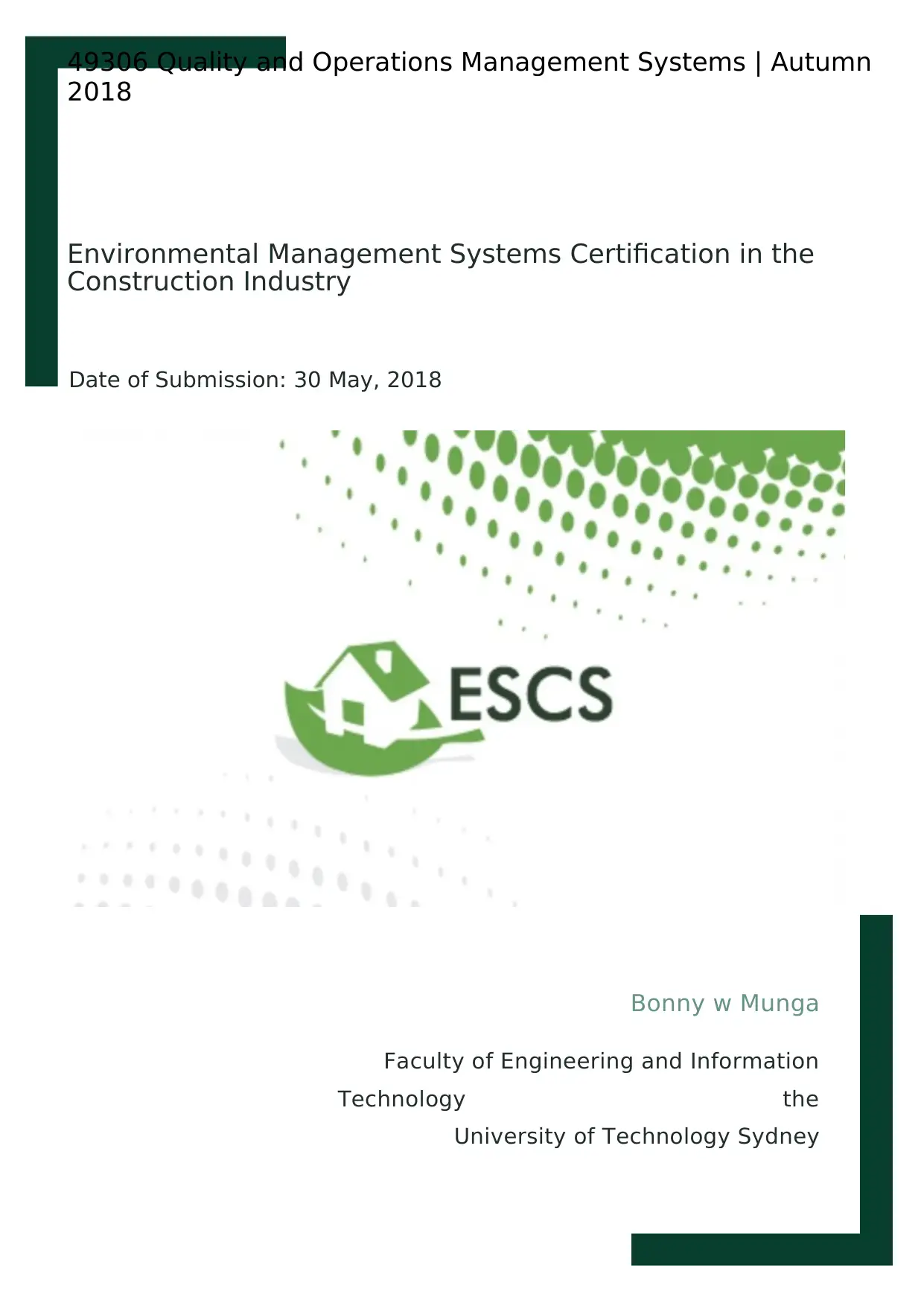
49306 Quality and Operations Management Systems | Autumn
2018
Environmental Management Systems Certification in the
Construction Industry
Bonny w Munga
Faculty of Engineering and Information
Technology the
University of Technology Sydney
Date of Submission: 30 May, 2018
2018
Environmental Management Systems Certification in the
Construction Industry
Bonny w Munga
Faculty of Engineering and Information
Technology the
University of Technology Sydney
Date of Submission: 30 May, 2018
Paraphrase This Document
Need a fresh take? Get an instant paraphrase of this document with our AI Paraphraser
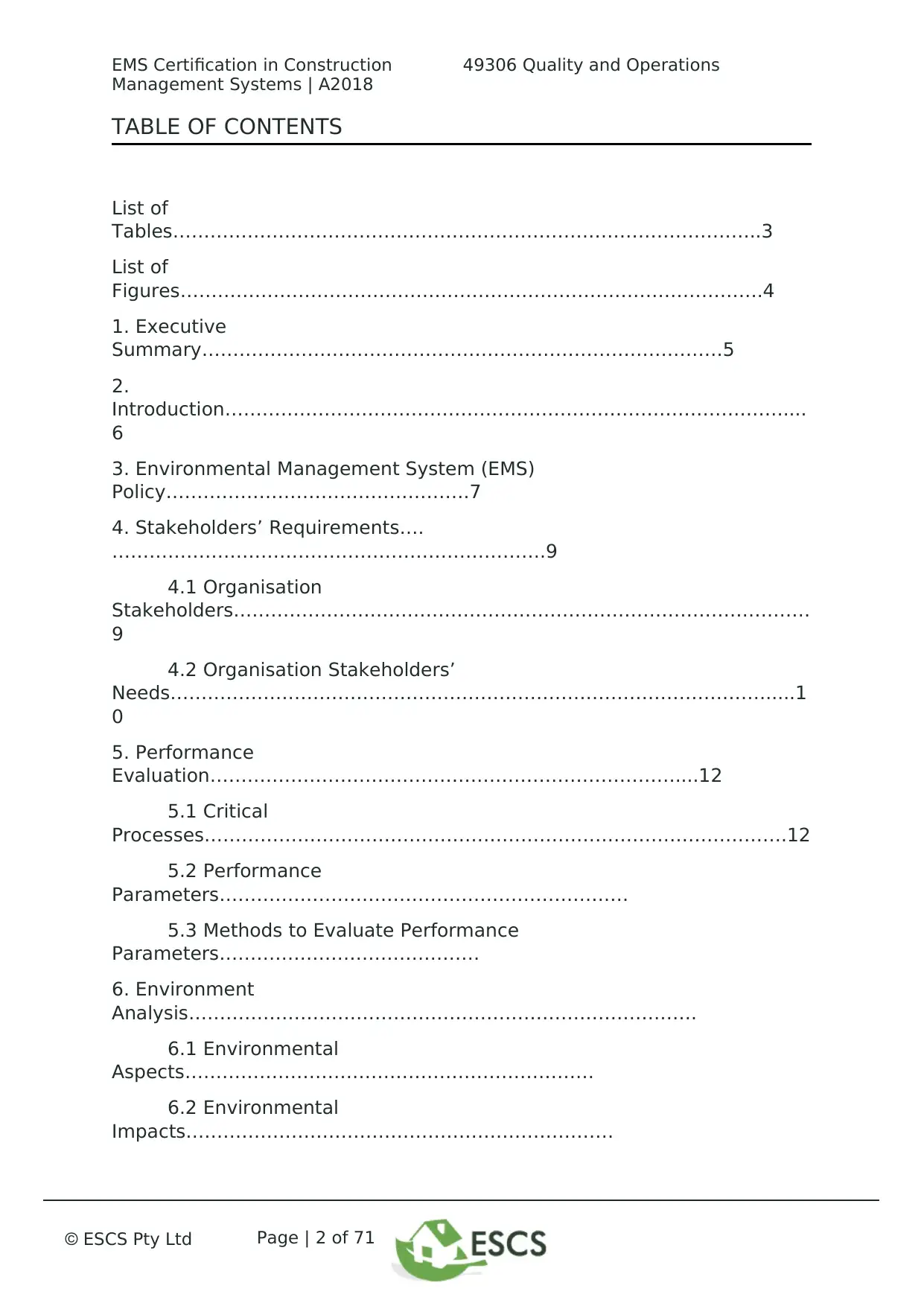
ESCS Pty Ltd
2018
EMS Certification in Construction 49306 Quality and Operations
Management Systems | A2018
TABLE OF CONTENTS
List of
Tables…………………………………………………………………………………..3
List of
Figures………………………………………………………………………………….4
1. Executive
Summary…………………………………………………………………………5
2.
Introduction………………………………………………………………………………....
6
3. Environmental Management System (EMS)
Policy………………………………………….7
4. Stakeholders’ Requirements….
…………………………………………………………….9
4.1 Organisation
Stakeholders…………………………………………………………………………………
9
4.2 Organisation Stakeholders’
Needs…………………………………………………………………………………….....1
0
5. Performance
Evaluation…………………………………………………………………....12
5.1 Critical
Processes………………………………………………………………………………….12
5.2 Performance
Parameters…………………………………………………………
5.3 Methods to Evaluate Performance
Parameters……………………………………
6. Environment
Analysis……………………………………………………………………….
6.1 Environmental
Aspects…………………………………………………………
6.2 Environmental
Impacts……………………………………………………………
Page | 2 of 71
2018
EMS Certification in Construction 49306 Quality and Operations
Management Systems | A2018
TABLE OF CONTENTS
List of
Tables…………………………………………………………………………………..3
List of
Figures………………………………………………………………………………….4
1. Executive
Summary…………………………………………………………………………5
2.
Introduction………………………………………………………………………………....
6
3. Environmental Management System (EMS)
Policy………………………………………….7
4. Stakeholders’ Requirements….
…………………………………………………………….9
4.1 Organisation
Stakeholders…………………………………………………………………………………
9
4.2 Organisation Stakeholders’
Needs…………………………………………………………………………………….....1
0
5. Performance
Evaluation…………………………………………………………………....12
5.1 Critical
Processes………………………………………………………………………………….12
5.2 Performance
Parameters…………………………………………………………
5.3 Methods to Evaluate Performance
Parameters……………………………………
6. Environment
Analysis……………………………………………………………………….
6.1 Environmental
Aspects…………………………………………………………
6.2 Environmental
Impacts……………………………………………………………
Page | 2 of 71
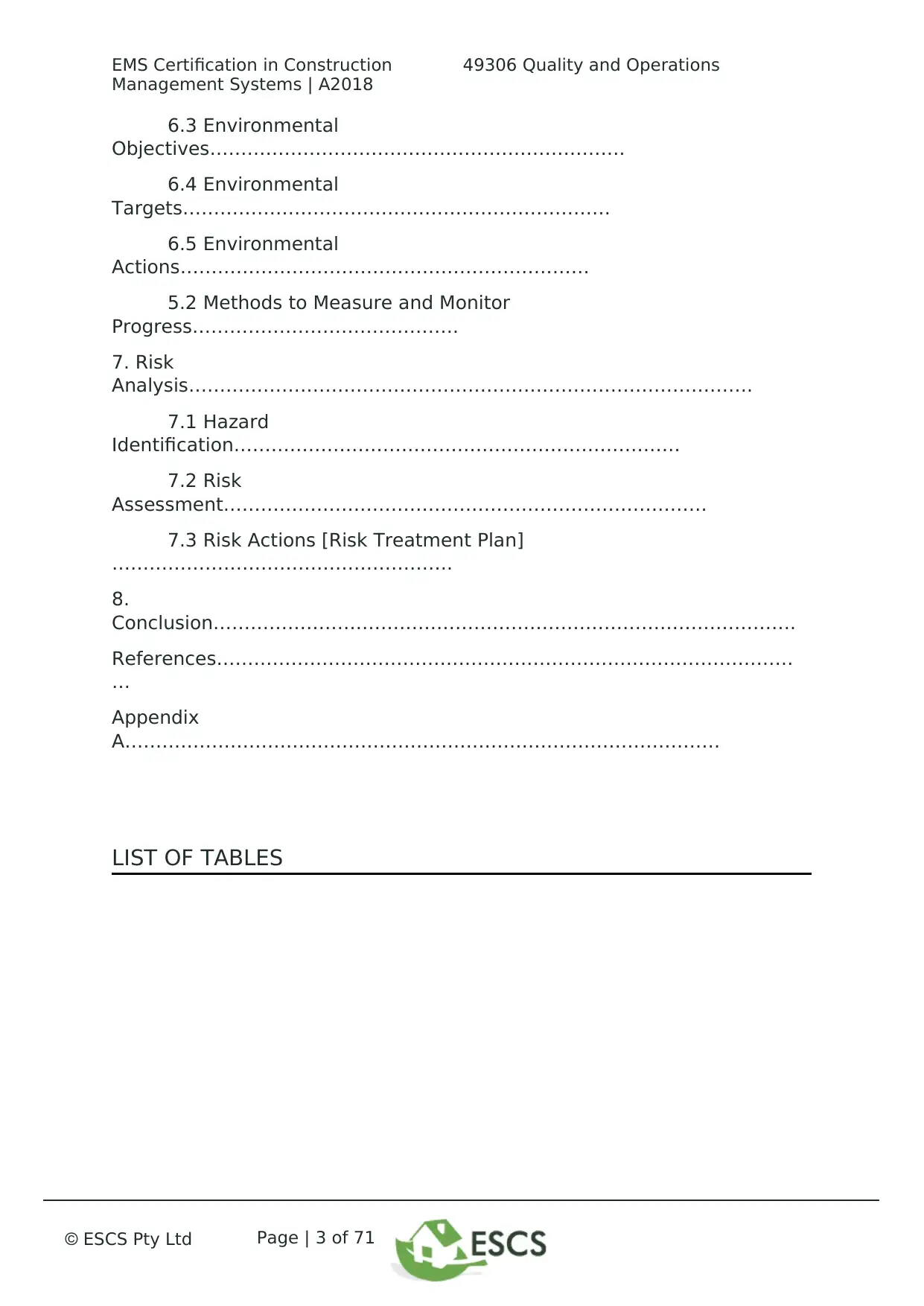
ESCS Pty Ltd
2018
EMS Certification in Construction 49306 Quality and Operations
Management Systems | A2018
6.3 Environmental
Objectives………………………………………………………….
6.4 Environmental
Targets……………………………………………………………
6.5 Environmental
Actions…………………………………………………………
5.2 Methods to Measure and Monitor
Progress…………………………………….
7. Risk
Analysis……………………………………………………………………………….
7.1 Hazard
Identification………………………………………………………………
7.2 Risk
Assessment……………………………………………………………………
7.3 Risk Actions [Risk Treatment Plan]
……………………………………………….
8.
Conclusion………………………………………………………………………………….
References…………………………………………………………………………………
…
Appendix
A……………………………………………………………………………………
LIST OF TABLES
Page | 3 of 71
2018
EMS Certification in Construction 49306 Quality and Operations
Management Systems | A2018
6.3 Environmental
Objectives………………………………………………………….
6.4 Environmental
Targets……………………………………………………………
6.5 Environmental
Actions…………………………………………………………
5.2 Methods to Measure and Monitor
Progress…………………………………….
7. Risk
Analysis……………………………………………………………………………….
7.1 Hazard
Identification………………………………………………………………
7.2 Risk
Assessment……………………………………………………………………
7.3 Risk Actions [Risk Treatment Plan]
……………………………………………….
8.
Conclusion………………………………………………………………………………….
References…………………………………………………………………………………
…
Appendix
A……………………………………………………………………………………
LIST OF TABLES
Page | 3 of 71
⊘ This is a preview!⊘
Do you want full access?
Subscribe today to unlock all pages.

Trusted by 1+ million students worldwide
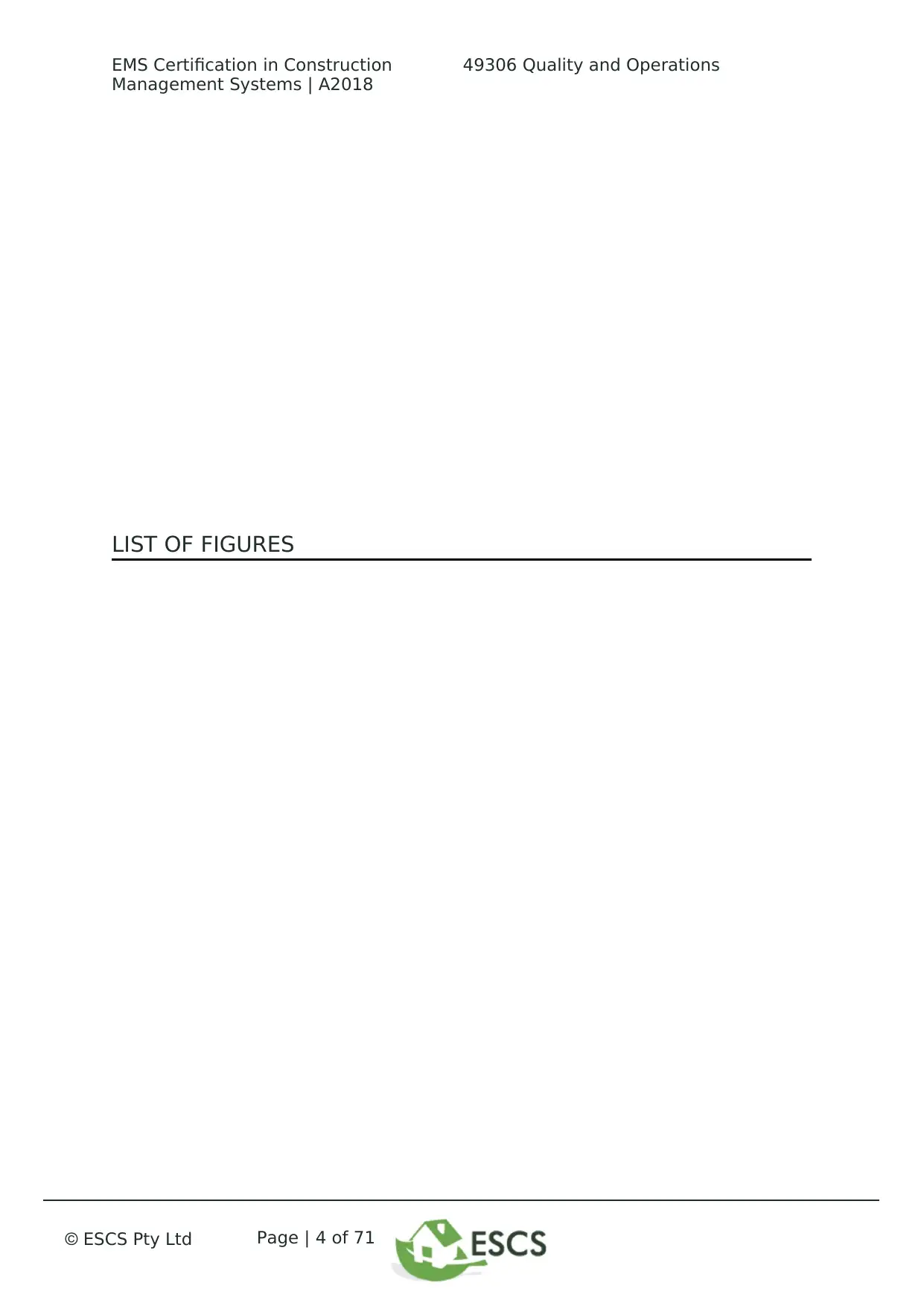
ESCS Pty Ltd
2018
EMS Certification in Construction 49306 Quality and Operations
Management Systems | A2018
LIST OF FIGURES
Page | 4 of 71
2018
EMS Certification in Construction 49306 Quality and Operations
Management Systems | A2018
LIST OF FIGURES
Page | 4 of 71
Paraphrase This Document
Need a fresh take? Get an instant paraphrase of this document with our AI Paraphraser
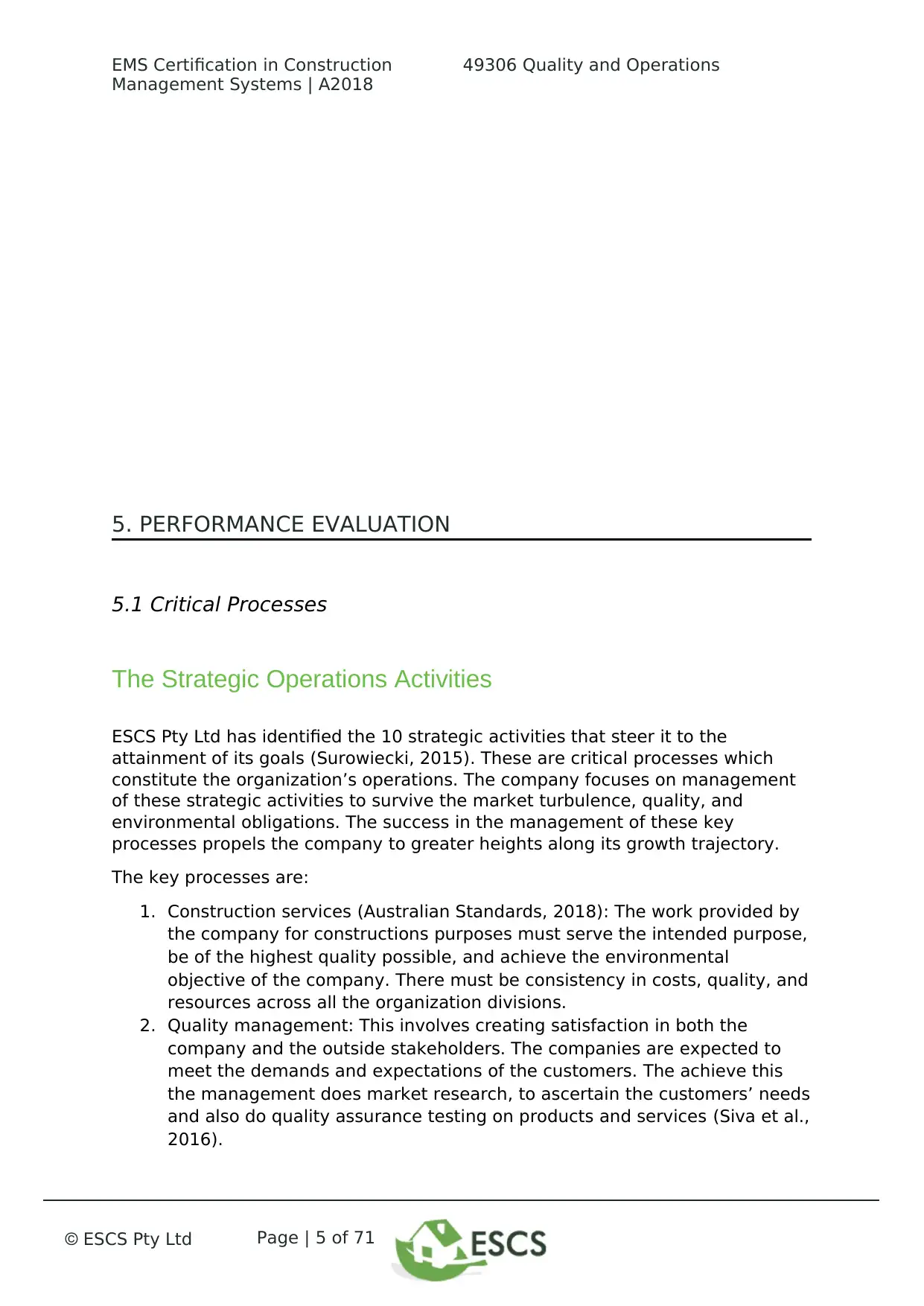
ESCS Pty Ltd
2018
EMS Certification in Construction 49306 Quality and Operations
Management Systems | A2018
5. PERFORMANCE EVALUATION
5.1 Critical Processes
The Strategic Operations Activities
ESCS Pty Ltd has identified the 10 strategic activities that steer it to the
attainment of its goals (Surowiecki, 2015). These are critical processes which
constitute the organization’s operations. The company focuses on management
of these strategic activities to survive the market turbulence, quality, and
environmental obligations. The success in the management of these key
processes propels the company to greater heights along its growth trajectory.
The key processes are:
1. Construction services (Australian Standards, 2018): The work provided by
the company for constructions purposes must serve the intended purpose,
be of the highest quality possible, and achieve the environmental
objective of the company. There must be consistency in costs, quality, and
resources across all the organization divisions.
2. Quality management: This involves creating satisfaction in both the
company and the outside stakeholders. The companies are expected to
meet the demands and expectations of the customers. The achieve this
the management does market research, to ascertain the customers’ needs
and also do quality assurance testing on products and services (Siva et al.,
2016).
Page | 5 of 71
2018
EMS Certification in Construction 49306 Quality and Operations
Management Systems | A2018
5. PERFORMANCE EVALUATION
5.1 Critical Processes
The Strategic Operations Activities
ESCS Pty Ltd has identified the 10 strategic activities that steer it to the
attainment of its goals (Surowiecki, 2015). These are critical processes which
constitute the organization’s operations. The company focuses on management
of these strategic activities to survive the market turbulence, quality, and
environmental obligations. The success in the management of these key
processes propels the company to greater heights along its growth trajectory.
The key processes are:
1. Construction services (Australian Standards, 2018): The work provided by
the company for constructions purposes must serve the intended purpose,
be of the highest quality possible, and achieve the environmental
objective of the company. There must be consistency in costs, quality, and
resources across all the organization divisions.
2. Quality management: This involves creating satisfaction in both the
company and the outside stakeholders. The companies are expected to
meet the demands and expectations of the customers. The achieve this
the management does market research, to ascertain the customers’ needs
and also do quality assurance testing on products and services (Siva et al.,
2016).
Page | 5 of 71
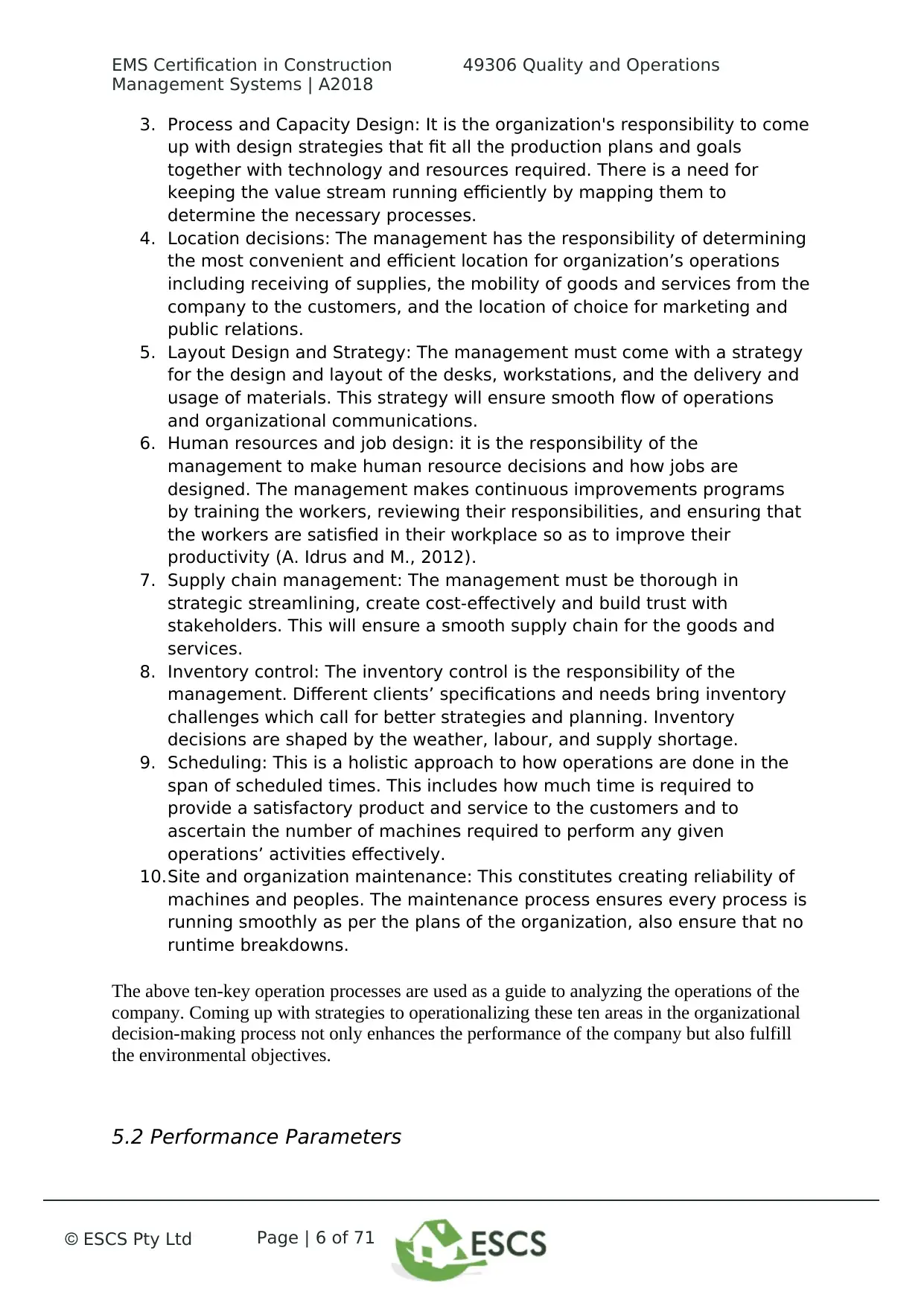
ESCS Pty Ltd
2018
EMS Certification in Construction 49306 Quality and Operations
Management Systems | A2018
3. Process and Capacity Design: It is the organization's responsibility to come
up with design strategies that fit all the production plans and goals
together with technology and resources required. There is a need for
keeping the value stream running efficiently by mapping them to
determine the necessary processes.
4. Location decisions: The management has the responsibility of determining
the most convenient and efficient location for organization’s operations
including receiving of supplies, the mobility of goods and services from the
company to the customers, and the location of choice for marketing and
public relations.
5. Layout Design and Strategy: The management must come with a strategy
for the design and layout of the desks, workstations, and the delivery and
usage of materials. This strategy will ensure smooth flow of operations
and organizational communications.
6. Human resources and job design: it is the responsibility of the
management to make human resource decisions and how jobs are
designed. The management makes continuous improvements programs
by training the workers, reviewing their responsibilities, and ensuring that
the workers are satisfied in their workplace so as to improve their
productivity (A. Idrus and M., 2012).
7. Supply chain management: The management must be thorough in
strategic streamlining, create cost-effectively and build trust with
stakeholders. This will ensure a smooth supply chain for the goods and
services.
8. Inventory control: The inventory control is the responsibility of the
management. Different clients’ specifications and needs bring inventory
challenges which call for better strategies and planning. Inventory
decisions are shaped by the weather, labour, and supply shortage.
9. Scheduling: This is a holistic approach to how operations are done in the
span of scheduled times. This includes how much time is required to
provide a satisfactory product and service to the customers and to
ascertain the number of machines required to perform any given
operations’ activities effectively.
10.Site and organization maintenance: This constitutes creating reliability of
machines and peoples. The maintenance process ensures every process is
running smoothly as per the plans of the organization, also ensure that no
runtime breakdowns.
The above ten-key operation processes are used as a guide to analyzing the operations of the
company. Coming up with strategies to operationalizing these ten areas in the organizational
decision-making process not only enhances the performance of the company but also fulfill
the environmental objectives.
5.2 Performance Parameters
Page | 6 of 71
2018
EMS Certification in Construction 49306 Quality and Operations
Management Systems | A2018
3. Process and Capacity Design: It is the organization's responsibility to come
up with design strategies that fit all the production plans and goals
together with technology and resources required. There is a need for
keeping the value stream running efficiently by mapping them to
determine the necessary processes.
4. Location decisions: The management has the responsibility of determining
the most convenient and efficient location for organization’s operations
including receiving of supplies, the mobility of goods and services from the
company to the customers, and the location of choice for marketing and
public relations.
5. Layout Design and Strategy: The management must come with a strategy
for the design and layout of the desks, workstations, and the delivery and
usage of materials. This strategy will ensure smooth flow of operations
and organizational communications.
6. Human resources and job design: it is the responsibility of the
management to make human resource decisions and how jobs are
designed. The management makes continuous improvements programs
by training the workers, reviewing their responsibilities, and ensuring that
the workers are satisfied in their workplace so as to improve their
productivity (A. Idrus and M., 2012).
7. Supply chain management: The management must be thorough in
strategic streamlining, create cost-effectively and build trust with
stakeholders. This will ensure a smooth supply chain for the goods and
services.
8. Inventory control: The inventory control is the responsibility of the
management. Different clients’ specifications and needs bring inventory
challenges which call for better strategies and planning. Inventory
decisions are shaped by the weather, labour, and supply shortage.
9. Scheduling: This is a holistic approach to how operations are done in the
span of scheduled times. This includes how much time is required to
provide a satisfactory product and service to the customers and to
ascertain the number of machines required to perform any given
operations’ activities effectively.
10.Site and organization maintenance: This constitutes creating reliability of
machines and peoples. The maintenance process ensures every process is
running smoothly as per the plans of the organization, also ensure that no
runtime breakdowns.
The above ten-key operation processes are used as a guide to analyzing the operations of the
company. Coming up with strategies to operationalizing these ten areas in the organizational
decision-making process not only enhances the performance of the company but also fulfill
the environmental objectives.
5.2 Performance Parameters
Page | 6 of 71
⊘ This is a preview!⊘
Do you want full access?
Subscribe today to unlock all pages.

Trusted by 1+ million students worldwide
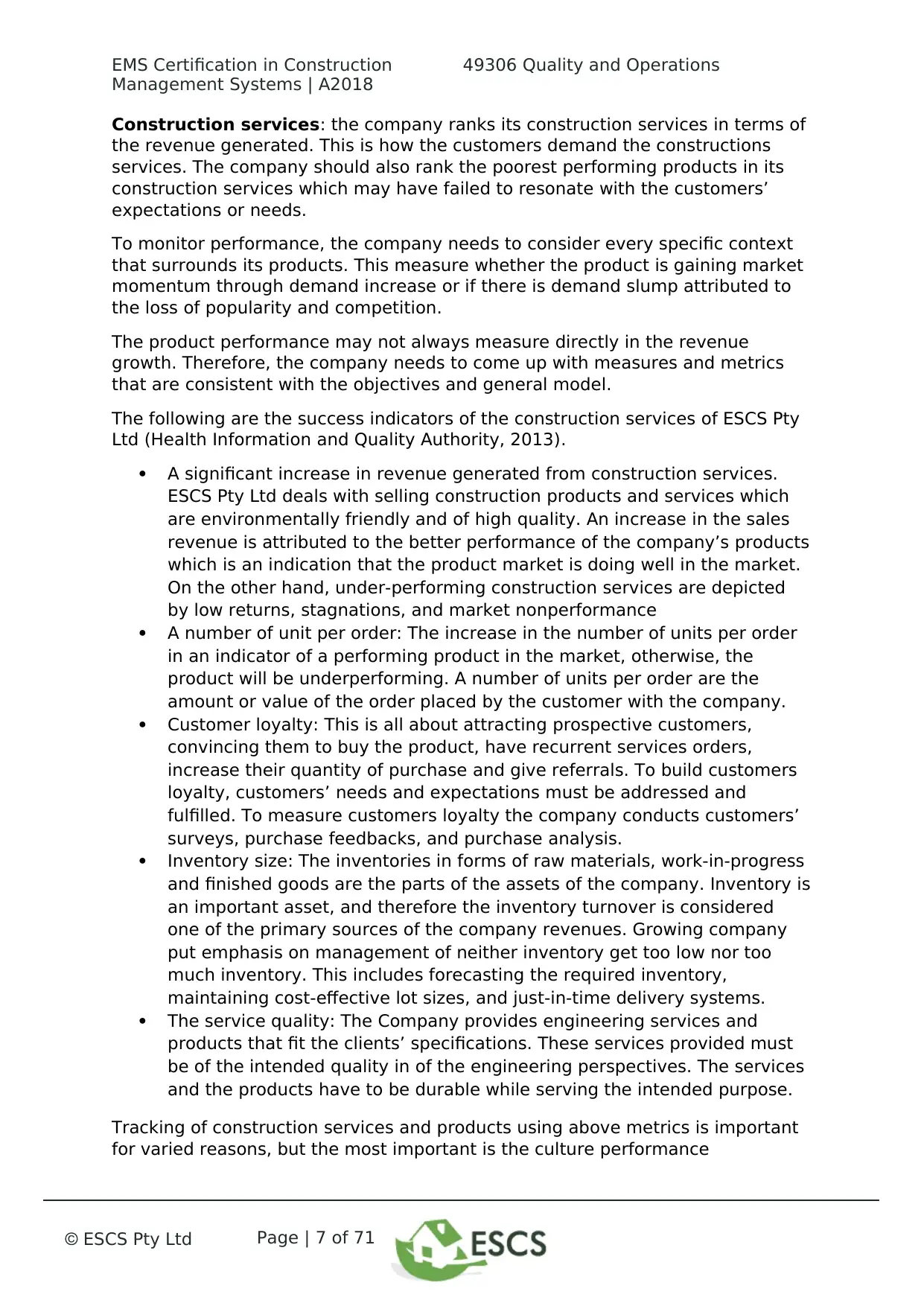
ESCS Pty Ltd
2018
EMS Certification in Construction 49306 Quality and Operations
Management Systems | A2018
Construction services: the company ranks its construction services in terms of
the revenue generated. This is how the customers demand the constructions
services. The company should also rank the poorest performing products in its
construction services which may have failed to resonate with the customers’
expectations or needs.
To monitor performance, the company needs to consider every specific context
that surrounds its products. This measure whether the product is gaining market
momentum through demand increase or if there is demand slump attributed to
the loss of popularity and competition.
The product performance may not always measure directly in the revenue
growth. Therefore, the company needs to come up with measures and metrics
that are consistent with the objectives and general model.
The following are the success indicators of the construction services of ESCS Pty
Ltd (Health Information and Quality Authority, 2013).
A significant increase in revenue generated from construction services.
ESCS Pty Ltd deals with selling construction products and services which
are environmentally friendly and of high quality. An increase in the sales
revenue is attributed to the better performance of the company’s products
which is an indication that the product market is doing well in the market.
On the other hand, under-performing construction services are depicted
by low returns, stagnations, and market nonperformance
A number of unit per order: The increase in the number of units per order
in an indicator of a performing product in the market, otherwise, the
product will be underperforming. A number of units per order are the
amount or value of the order placed by the customer with the company.
Customer loyalty: This is all about attracting prospective customers,
convincing them to buy the product, have recurrent services orders,
increase their quantity of purchase and give referrals. To build customers
loyalty, customers’ needs and expectations must be addressed and
fulfilled. To measure customers loyalty the company conducts customers’
surveys, purchase feedbacks, and purchase analysis.
Inventory size: The inventories in forms of raw materials, work-in-progress
and finished goods are the parts of the assets of the company. Inventory is
an important asset, and therefore the inventory turnover is considered
one of the primary sources of the company revenues. Growing company
put emphasis on management of neither inventory get too low nor too
much inventory. This includes forecasting the required inventory,
maintaining cost-effective lot sizes, and just-in-time delivery systems.
The service quality: The Company provides engineering services and
products that fit the clients’ specifications. These services provided must
be of the intended quality in of the engineering perspectives. The services
and the products have to be durable while serving the intended purpose.
Tracking of construction services and products using above metrics is important
for varied reasons, but the most important is the culture performance
Page | 7 of 71
2018
EMS Certification in Construction 49306 Quality and Operations
Management Systems | A2018
Construction services: the company ranks its construction services in terms of
the revenue generated. This is how the customers demand the constructions
services. The company should also rank the poorest performing products in its
construction services which may have failed to resonate with the customers’
expectations or needs.
To monitor performance, the company needs to consider every specific context
that surrounds its products. This measure whether the product is gaining market
momentum through demand increase or if there is demand slump attributed to
the loss of popularity and competition.
The product performance may not always measure directly in the revenue
growth. Therefore, the company needs to come up with measures and metrics
that are consistent with the objectives and general model.
The following are the success indicators of the construction services of ESCS Pty
Ltd (Health Information and Quality Authority, 2013).
A significant increase in revenue generated from construction services.
ESCS Pty Ltd deals with selling construction products and services which
are environmentally friendly and of high quality. An increase in the sales
revenue is attributed to the better performance of the company’s products
which is an indication that the product market is doing well in the market.
On the other hand, under-performing construction services are depicted
by low returns, stagnations, and market nonperformance
A number of unit per order: The increase in the number of units per order
in an indicator of a performing product in the market, otherwise, the
product will be underperforming. A number of units per order are the
amount or value of the order placed by the customer with the company.
Customer loyalty: This is all about attracting prospective customers,
convincing them to buy the product, have recurrent services orders,
increase their quantity of purchase and give referrals. To build customers
loyalty, customers’ needs and expectations must be addressed and
fulfilled. To measure customers loyalty the company conducts customers’
surveys, purchase feedbacks, and purchase analysis.
Inventory size: The inventories in forms of raw materials, work-in-progress
and finished goods are the parts of the assets of the company. Inventory is
an important asset, and therefore the inventory turnover is considered
one of the primary sources of the company revenues. Growing company
put emphasis on management of neither inventory get too low nor too
much inventory. This includes forecasting the required inventory,
maintaining cost-effective lot sizes, and just-in-time delivery systems.
The service quality: The Company provides engineering services and
products that fit the clients’ specifications. These services provided must
be of the intended quality in of the engineering perspectives. The services
and the products have to be durable while serving the intended purpose.
Tracking of construction services and products using above metrics is important
for varied reasons, but the most important is the culture performance
Page | 7 of 71
Paraphrase This Document
Need a fresh take? Get an instant paraphrase of this document with our AI Paraphraser
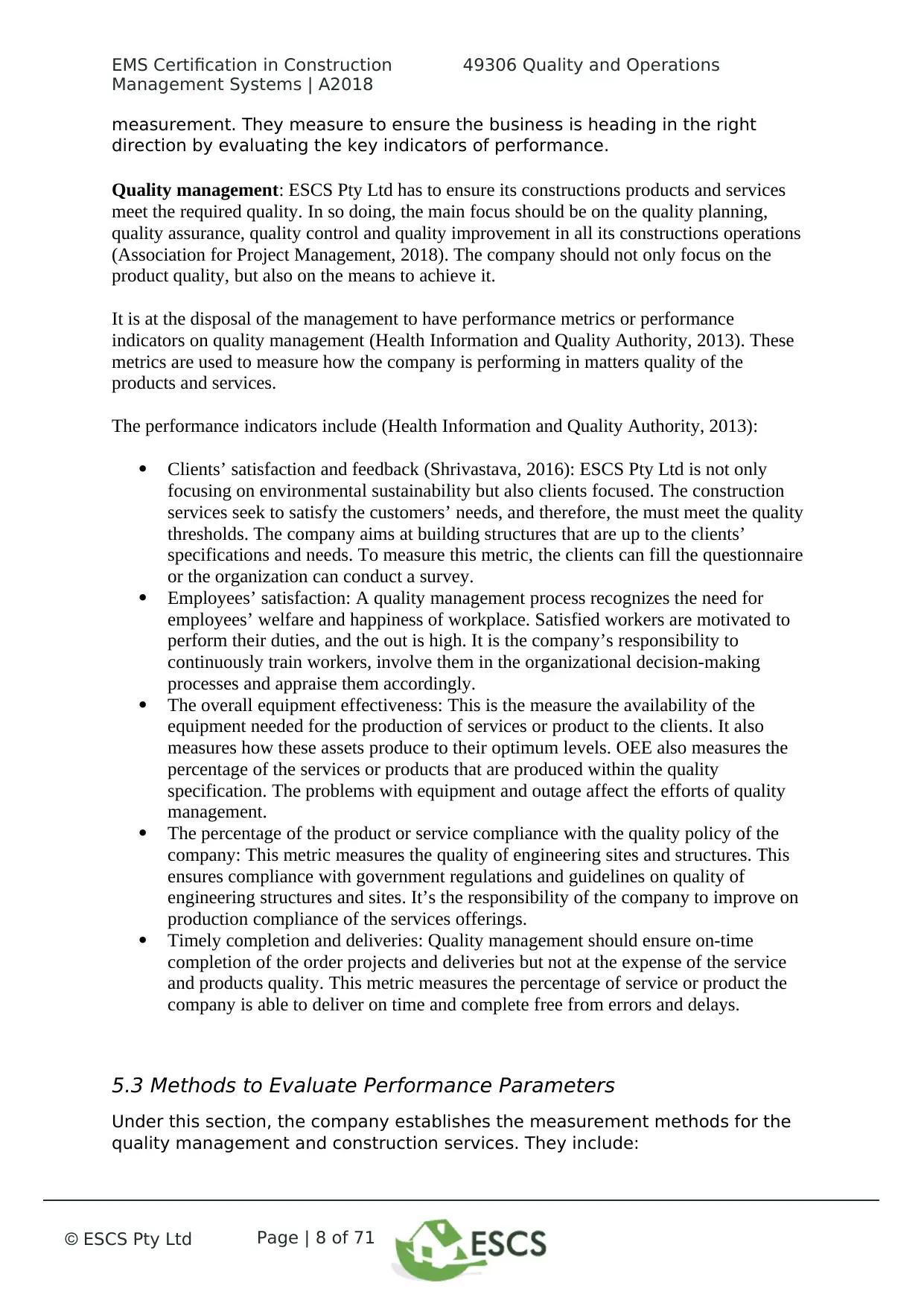
ESCS Pty Ltd
2018
EMS Certification in Construction 49306 Quality and Operations
Management Systems | A2018
measurement. They measure to ensure the business is heading in the right
direction by evaluating the key indicators of performance.
Quality management: ESCS Pty Ltd has to ensure its constructions products and services
meet the required quality. In so doing, the main focus should be on the quality planning,
quality assurance, quality control and quality improvement in all its constructions operations
(Association for Project Management, 2018). The company should not only focus on the
product quality, but also on the means to achieve it.
It is at the disposal of the management to have performance metrics or performance
indicators on quality management (Health Information and Quality Authority, 2013). These
metrics are used to measure how the company is performing in matters quality of the
products and services.
The performance indicators include (Health Information and Quality Authority, 2013):
Clients’ satisfaction and feedback (Shrivastava, 2016): ESCS Pty Ltd is not only
focusing on environmental sustainability but also clients focused. The construction
services seek to satisfy the customers’ needs, and therefore, the must meet the quality
thresholds. The company aims at building structures that are up to the clients’
specifications and needs. To measure this metric, the clients can fill the questionnaire
or the organization can conduct a survey.
Employees’ satisfaction: A quality management process recognizes the need for
employees’ welfare and happiness of workplace. Satisfied workers are motivated to
perform their duties, and the out is high. It is the company’s responsibility to
continuously train workers, involve them in the organizational decision-making
processes and appraise them accordingly.
The overall equipment effectiveness: This is the measure the availability of the
equipment needed for the production of services or product to the clients. It also
measures how these assets produce to their optimum levels. OEE also measures the
percentage of the services or products that are produced within the quality
specification. The problems with equipment and outage affect the efforts of quality
management.
The percentage of the product or service compliance with the quality policy of the
company: This metric measures the quality of engineering sites and structures. This
ensures compliance with government regulations and guidelines on quality of
engineering structures and sites. It’s the responsibility of the company to improve on
production compliance of the services offerings.
Timely completion and deliveries: Quality management should ensure on-time
completion of the order projects and deliveries but not at the expense of the service
and products quality. This metric measures the percentage of service or product the
company is able to deliver on time and complete free from errors and delays.
5.3 Methods to Evaluate Performance Parameters
Under this section, the company establishes the measurement methods for the
quality management and construction services. They include:
Page | 8 of 71
2018
EMS Certification in Construction 49306 Quality and Operations
Management Systems | A2018
measurement. They measure to ensure the business is heading in the right
direction by evaluating the key indicators of performance.
Quality management: ESCS Pty Ltd has to ensure its constructions products and services
meet the required quality. In so doing, the main focus should be on the quality planning,
quality assurance, quality control and quality improvement in all its constructions operations
(Association for Project Management, 2018). The company should not only focus on the
product quality, but also on the means to achieve it.
It is at the disposal of the management to have performance metrics or performance
indicators on quality management (Health Information and Quality Authority, 2013). These
metrics are used to measure how the company is performing in matters quality of the
products and services.
The performance indicators include (Health Information and Quality Authority, 2013):
Clients’ satisfaction and feedback (Shrivastava, 2016): ESCS Pty Ltd is not only
focusing on environmental sustainability but also clients focused. The construction
services seek to satisfy the customers’ needs, and therefore, the must meet the quality
thresholds. The company aims at building structures that are up to the clients’
specifications and needs. To measure this metric, the clients can fill the questionnaire
or the organization can conduct a survey.
Employees’ satisfaction: A quality management process recognizes the need for
employees’ welfare and happiness of workplace. Satisfied workers are motivated to
perform their duties, and the out is high. It is the company’s responsibility to
continuously train workers, involve them in the organizational decision-making
processes and appraise them accordingly.
The overall equipment effectiveness: This is the measure the availability of the
equipment needed for the production of services or product to the clients. It also
measures how these assets produce to their optimum levels. OEE also measures the
percentage of the services or products that are produced within the quality
specification. The problems with equipment and outage affect the efforts of quality
management.
The percentage of the product or service compliance with the quality policy of the
company: This metric measures the quality of engineering sites and structures. This
ensures compliance with government regulations and guidelines on quality of
engineering structures and sites. It’s the responsibility of the company to improve on
production compliance of the services offerings.
Timely completion and deliveries: Quality management should ensure on-time
completion of the order projects and deliveries but not at the expense of the service
and products quality. This metric measures the percentage of service or product the
company is able to deliver on time and complete free from errors and delays.
5.3 Methods to Evaluate Performance Parameters
Under this section, the company establishes the measurement methods for the
quality management and construction services. They include:
Page | 8 of 71
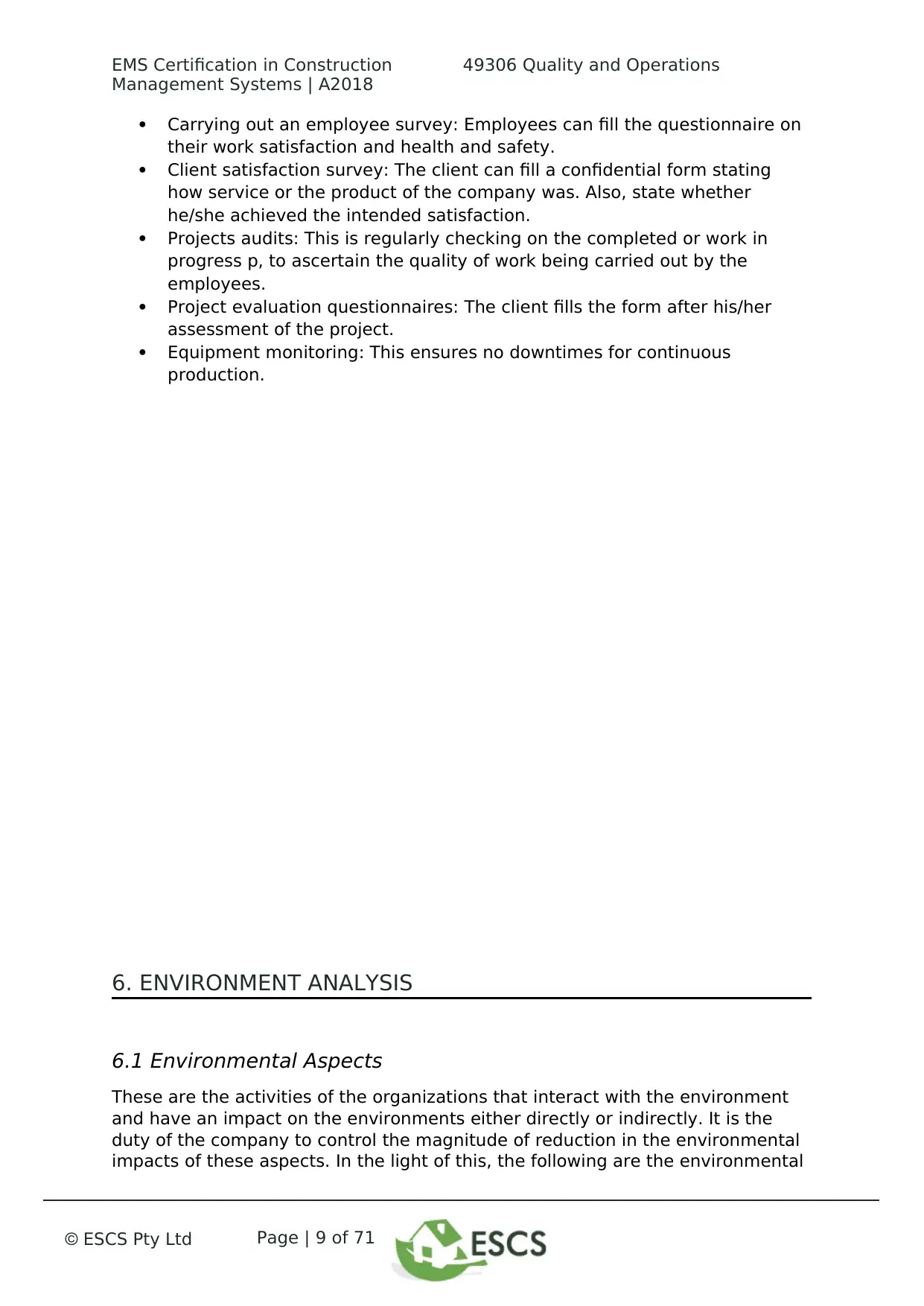
ESCS Pty Ltd
2018
EMS Certification in Construction 49306 Quality and Operations
Management Systems | A2018
Carrying out an employee survey: Employees can fill the questionnaire on
their work satisfaction and health and safety.
Client satisfaction survey: The client can fill a confidential form stating
how service or the product of the company was. Also, state whether
he/she achieved the intended satisfaction.
Projects audits: This is regularly checking on the completed or work in
progress p, to ascertain the quality of work being carried out by the
employees.
Project evaluation questionnaires: The client fills the form after his/her
assessment of the project.
Equipment monitoring: This ensures no downtimes for continuous
production.
6. ENVIRONMENT ANALYSIS
6.1 Environmental Aspects
These are the activities of the organizations that interact with the environment
and have an impact on the environments either directly or indirectly. It is the
duty of the company to control the magnitude of reduction in the environmental
impacts of these aspects. In the light of this, the following are the environmental
Page | 9 of 71
2018
EMS Certification in Construction 49306 Quality and Operations
Management Systems | A2018
Carrying out an employee survey: Employees can fill the questionnaire on
their work satisfaction and health and safety.
Client satisfaction survey: The client can fill a confidential form stating
how service or the product of the company was. Also, state whether
he/she achieved the intended satisfaction.
Projects audits: This is regularly checking on the completed or work in
progress p, to ascertain the quality of work being carried out by the
employees.
Project evaluation questionnaires: The client fills the form after his/her
assessment of the project.
Equipment monitoring: This ensures no downtimes for continuous
production.
6. ENVIRONMENT ANALYSIS
6.1 Environmental Aspects
These are the activities of the organizations that interact with the environment
and have an impact on the environments either directly or indirectly. It is the
duty of the company to control the magnitude of reduction in the environmental
impacts of these aspects. In the light of this, the following are the environmental
Page | 9 of 71
⊘ This is a preview!⊘
Do you want full access?
Subscribe today to unlock all pages.

Trusted by 1+ million students worldwide
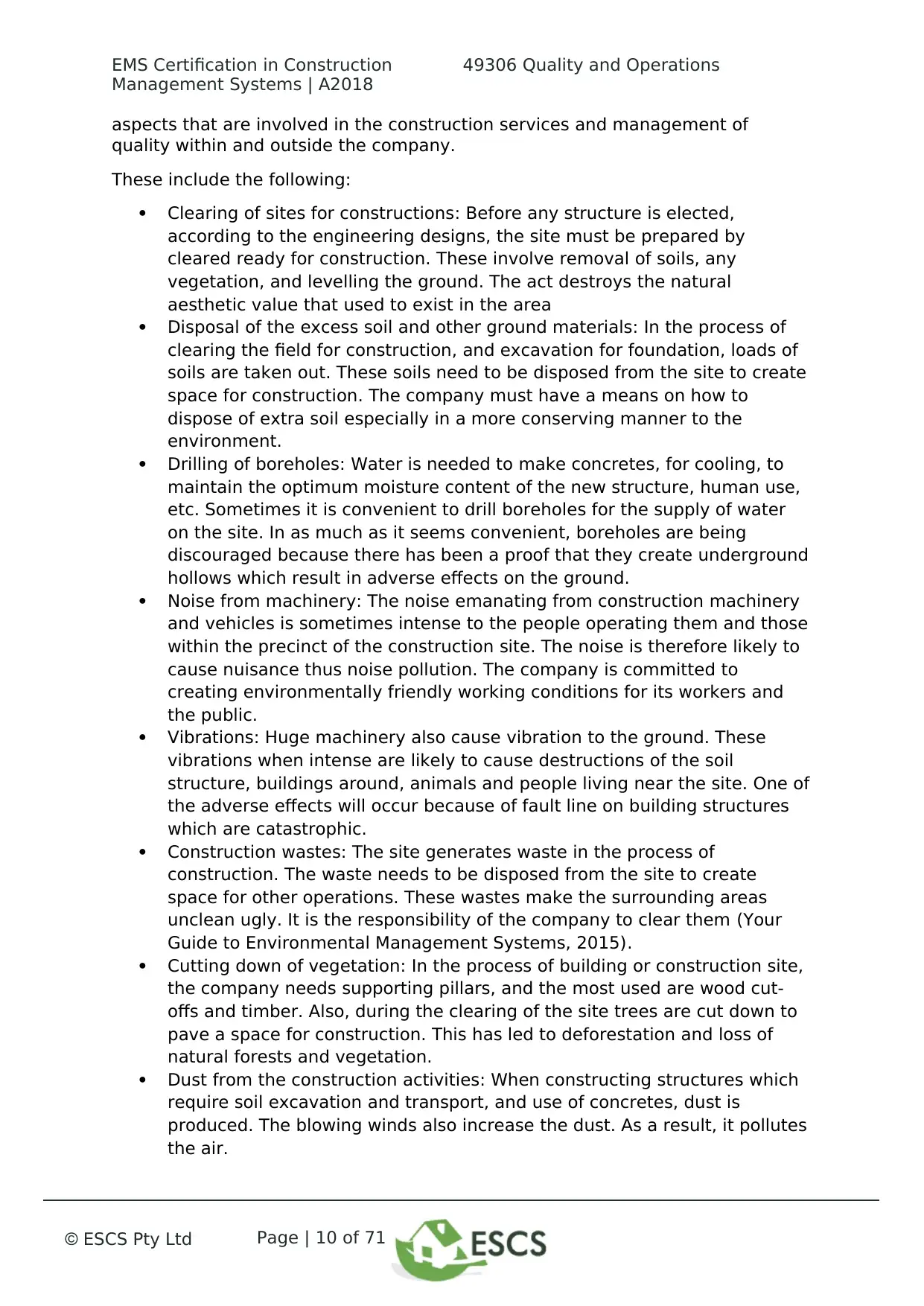
ESCS Pty Ltd
2018
EMS Certification in Construction 49306 Quality and Operations
Management Systems | A2018
aspects that are involved in the construction services and management of
quality within and outside the company.
These include the following:
Clearing of sites for constructions: Before any structure is elected,
according to the engineering designs, the site must be prepared by
cleared ready for construction. These involve removal of soils, any
vegetation, and levelling the ground. The act destroys the natural
aesthetic value that used to exist in the area
Disposal of the excess soil and other ground materials: In the process of
clearing the field for construction, and excavation for foundation, loads of
soils are taken out. These soils need to be disposed from the site to create
space for construction. The company must have a means on how to
dispose of extra soil especially in a more conserving manner to the
environment.
Drilling of boreholes: Water is needed to make concretes, for cooling, to
maintain the optimum moisture content of the new structure, human use,
etc. Sometimes it is convenient to drill boreholes for the supply of water
on the site. In as much as it seems convenient, boreholes are being
discouraged because there has been a proof that they create underground
hollows which result in adverse effects on the ground.
Noise from machinery: The noise emanating from construction machinery
and vehicles is sometimes intense to the people operating them and those
within the precinct of the construction site. The noise is therefore likely to
cause nuisance thus noise pollution. The company is committed to
creating environmentally friendly working conditions for its workers and
the public.
Vibrations: Huge machinery also cause vibration to the ground. These
vibrations when intense are likely to cause destructions of the soil
structure, buildings around, animals and people living near the site. One of
the adverse effects will occur because of fault line on building structures
which are catastrophic.
Construction wastes: The site generates waste in the process of
construction. The waste needs to be disposed from the site to create
space for other operations. These wastes make the surrounding areas
unclean ugly. It is the responsibility of the company to clear them (Your
Guide to Environmental Management Systems, 2015).
Cutting down of vegetation: In the process of building or construction site,
the company needs supporting pillars, and the most used are wood cut-
offs and timber. Also, during the clearing of the site trees are cut down to
pave a space for construction. This has led to deforestation and loss of
natural forests and vegetation.
Dust from the construction activities: When constructing structures which
require soil excavation and transport, and use of concretes, dust is
produced. The blowing winds also increase the dust. As a result, it pollutes
the air.
Page | 10 of 71
2018
EMS Certification in Construction 49306 Quality and Operations
Management Systems | A2018
aspects that are involved in the construction services and management of
quality within and outside the company.
These include the following:
Clearing of sites for constructions: Before any structure is elected,
according to the engineering designs, the site must be prepared by
cleared ready for construction. These involve removal of soils, any
vegetation, and levelling the ground. The act destroys the natural
aesthetic value that used to exist in the area
Disposal of the excess soil and other ground materials: In the process of
clearing the field for construction, and excavation for foundation, loads of
soils are taken out. These soils need to be disposed from the site to create
space for construction. The company must have a means on how to
dispose of extra soil especially in a more conserving manner to the
environment.
Drilling of boreholes: Water is needed to make concretes, for cooling, to
maintain the optimum moisture content of the new structure, human use,
etc. Sometimes it is convenient to drill boreholes for the supply of water
on the site. In as much as it seems convenient, boreholes are being
discouraged because there has been a proof that they create underground
hollows which result in adverse effects on the ground.
Noise from machinery: The noise emanating from construction machinery
and vehicles is sometimes intense to the people operating them and those
within the precinct of the construction site. The noise is therefore likely to
cause nuisance thus noise pollution. The company is committed to
creating environmentally friendly working conditions for its workers and
the public.
Vibrations: Huge machinery also cause vibration to the ground. These
vibrations when intense are likely to cause destructions of the soil
structure, buildings around, animals and people living near the site. One of
the adverse effects will occur because of fault line on building structures
which are catastrophic.
Construction wastes: The site generates waste in the process of
construction. The waste needs to be disposed from the site to create
space for other operations. These wastes make the surrounding areas
unclean ugly. It is the responsibility of the company to clear them (Your
Guide to Environmental Management Systems, 2015).
Cutting down of vegetation: In the process of building or construction site,
the company needs supporting pillars, and the most used are wood cut-
offs and timber. Also, during the clearing of the site trees are cut down to
pave a space for construction. This has led to deforestation and loss of
natural forests and vegetation.
Dust from the construction activities: When constructing structures which
require soil excavation and transport, and use of concretes, dust is
produced. The blowing winds also increase the dust. As a result, it pollutes
the air.
Page | 10 of 71
Paraphrase This Document
Need a fresh take? Get an instant paraphrase of this document with our AI Paraphraser
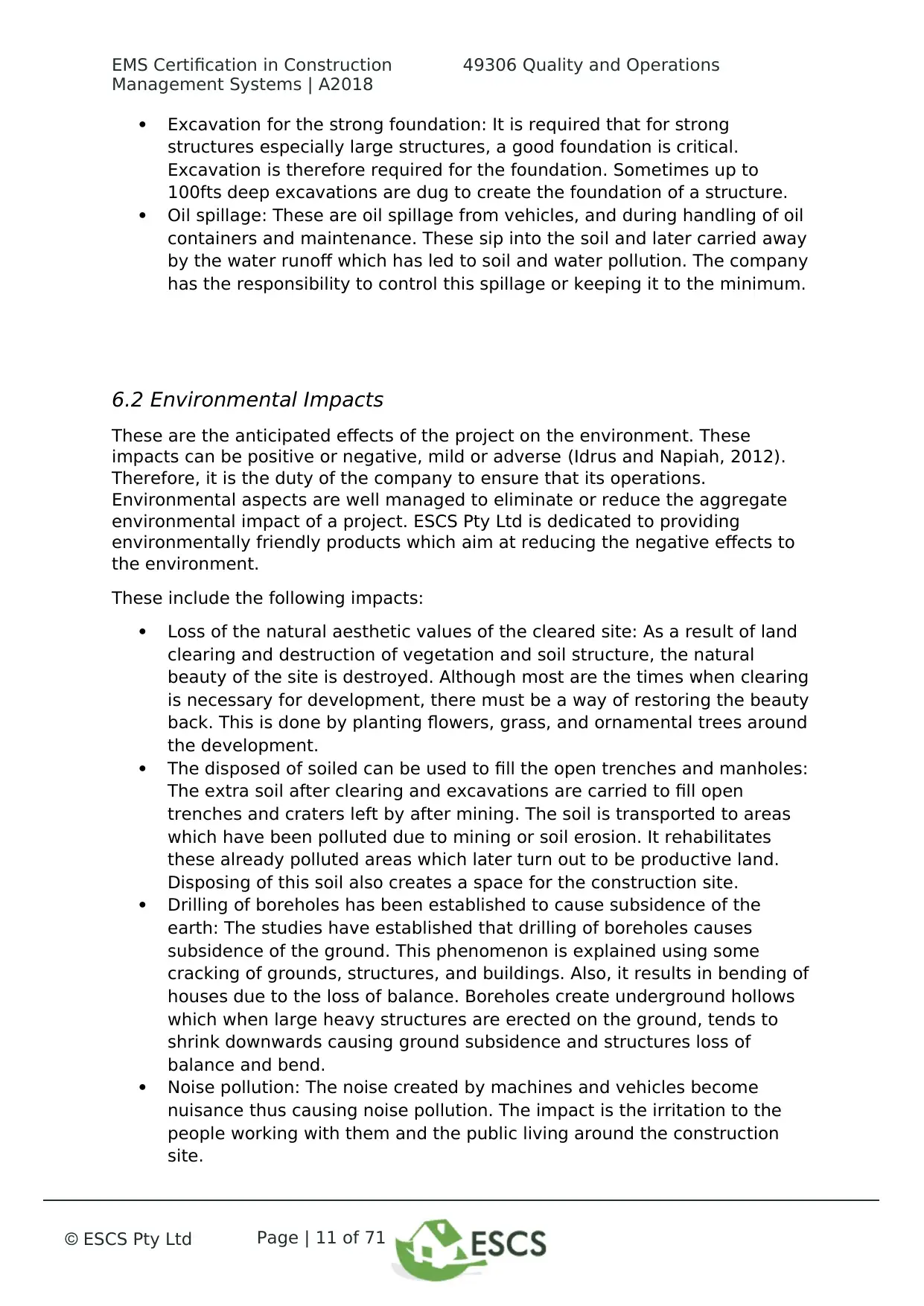
ESCS Pty Ltd
2018
EMS Certification in Construction 49306 Quality and Operations
Management Systems | A2018
Excavation for the strong foundation: It is required that for strong
structures especially large structures, a good foundation is critical.
Excavation is therefore required for the foundation. Sometimes up to
100fts deep excavations are dug to create the foundation of a structure.
Oil spillage: These are oil spillage from vehicles, and during handling of oil
containers and maintenance. These sip into the soil and later carried away
by the water runoff which has led to soil and water pollution. The company
has the responsibility to control this spillage or keeping it to the minimum.
6.2 Environmental Impacts
These are the anticipated effects of the project on the environment. These
impacts can be positive or negative, mild or adverse (Idrus and Napiah, 2012).
Therefore, it is the duty of the company to ensure that its operations.
Environmental aspects are well managed to eliminate or reduce the aggregate
environmental impact of a project. ESCS Pty Ltd is dedicated to providing
environmentally friendly products which aim at reducing the negative effects to
the environment.
These include the following impacts:
Loss of the natural aesthetic values of the cleared site: As a result of land
clearing and destruction of vegetation and soil structure, the natural
beauty of the site is destroyed. Although most are the times when clearing
is necessary for development, there must be a way of restoring the beauty
back. This is done by planting flowers, grass, and ornamental trees around
the development.
The disposed of soiled can be used to fill the open trenches and manholes:
The extra soil after clearing and excavations are carried to fill open
trenches and craters left by after mining. The soil is transported to areas
which have been polluted due to mining or soil erosion. It rehabilitates
these already polluted areas which later turn out to be productive land.
Disposing of this soil also creates a space for the construction site.
Drilling of boreholes has been established to cause subsidence of the
earth: The studies have established that drilling of boreholes causes
subsidence of the ground. This phenomenon is explained using some
cracking of grounds, structures, and buildings. Also, it results in bending of
houses due to the loss of balance. Boreholes create underground hollows
which when large heavy structures are erected on the ground, tends to
shrink downwards causing ground subsidence and structures loss of
balance and bend.
Noise pollution: The noise created by machines and vehicles become
nuisance thus causing noise pollution. The impact is the irritation to the
people working with them and the public living around the construction
site.
Page | 11 of 71
2018
EMS Certification in Construction 49306 Quality and Operations
Management Systems | A2018
Excavation for the strong foundation: It is required that for strong
structures especially large structures, a good foundation is critical.
Excavation is therefore required for the foundation. Sometimes up to
100fts deep excavations are dug to create the foundation of a structure.
Oil spillage: These are oil spillage from vehicles, and during handling of oil
containers and maintenance. These sip into the soil and later carried away
by the water runoff which has led to soil and water pollution. The company
has the responsibility to control this spillage or keeping it to the minimum.
6.2 Environmental Impacts
These are the anticipated effects of the project on the environment. These
impacts can be positive or negative, mild or adverse (Idrus and Napiah, 2012).
Therefore, it is the duty of the company to ensure that its operations.
Environmental aspects are well managed to eliminate or reduce the aggregate
environmental impact of a project. ESCS Pty Ltd is dedicated to providing
environmentally friendly products which aim at reducing the negative effects to
the environment.
These include the following impacts:
Loss of the natural aesthetic values of the cleared site: As a result of land
clearing and destruction of vegetation and soil structure, the natural
beauty of the site is destroyed. Although most are the times when clearing
is necessary for development, there must be a way of restoring the beauty
back. This is done by planting flowers, grass, and ornamental trees around
the development.
The disposed of soiled can be used to fill the open trenches and manholes:
The extra soil after clearing and excavations are carried to fill open
trenches and craters left by after mining. The soil is transported to areas
which have been polluted due to mining or soil erosion. It rehabilitates
these already polluted areas which later turn out to be productive land.
Disposing of this soil also creates a space for the construction site.
Drilling of boreholes has been established to cause subsidence of the
earth: The studies have established that drilling of boreholes causes
subsidence of the ground. This phenomenon is explained using some
cracking of grounds, structures, and buildings. Also, it results in bending of
houses due to the loss of balance. Boreholes create underground hollows
which when large heavy structures are erected on the ground, tends to
shrink downwards causing ground subsidence and structures loss of
balance and bend.
Noise pollution: The noise created by machines and vehicles become
nuisance thus causing noise pollution. The impact is the irritation to the
people working with them and the public living around the construction
site.
Page | 11 of 71
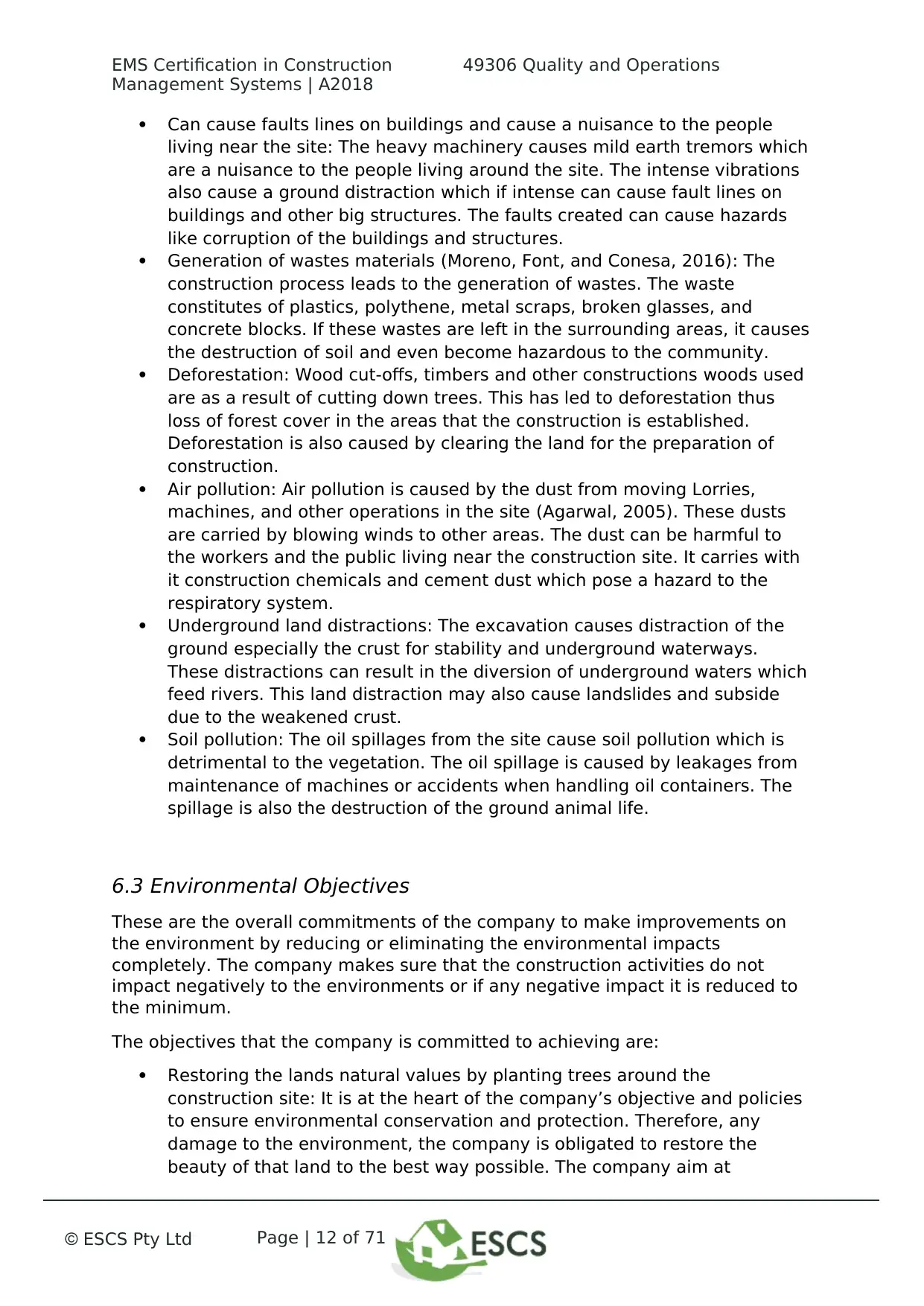
ESCS Pty Ltd
2018
EMS Certification in Construction 49306 Quality and Operations
Management Systems | A2018
Can cause faults lines on buildings and cause a nuisance to the people
living near the site: The heavy machinery causes mild earth tremors which
are a nuisance to the people living around the site. The intense vibrations
also cause a ground distraction which if intense can cause fault lines on
buildings and other big structures. The faults created can cause hazards
like corruption of the buildings and structures.
Generation of wastes materials (Moreno, Font, and Conesa, 2016): The
construction process leads to the generation of wastes. The waste
constitutes of plastics, polythene, metal scraps, broken glasses, and
concrete blocks. If these wastes are left in the surrounding areas, it causes
the destruction of soil and even become hazardous to the community.
Deforestation: Wood cut-offs, timbers and other constructions woods used
are as a result of cutting down trees. This has led to deforestation thus
loss of forest cover in the areas that the construction is established.
Deforestation is also caused by clearing the land for the preparation of
construction.
Air pollution: Air pollution is caused by the dust from moving Lorries,
machines, and other operations in the site (Agarwal, 2005). These dusts
are carried by blowing winds to other areas. The dust can be harmful to
the workers and the public living near the construction site. It carries with
it construction chemicals and cement dust which pose a hazard to the
respiratory system.
Underground land distractions: The excavation causes distraction of the
ground especially the crust for stability and underground waterways.
These distractions can result in the diversion of underground waters which
feed rivers. This land distraction may also cause landslides and subside
due to the weakened crust.
Soil pollution: The oil spillages from the site cause soil pollution which is
detrimental to the vegetation. The oil spillage is caused by leakages from
maintenance of machines or accidents when handling oil containers. The
spillage is also the destruction of the ground animal life.
6.3 Environmental Objectives
These are the overall commitments of the company to make improvements on
the environment by reducing or eliminating the environmental impacts
completely. The company makes sure that the construction activities do not
impact negatively to the environments or if any negative impact it is reduced to
the minimum.
The objectives that the company is committed to achieving are:
Restoring the lands natural values by planting trees around the
construction site: It is at the heart of the company’s objective and policies
to ensure environmental conservation and protection. Therefore, any
damage to the environment, the company is obligated to restore the
beauty of that land to the best way possible. The company aim at
Page | 12 of 71
2018
EMS Certification in Construction 49306 Quality and Operations
Management Systems | A2018
Can cause faults lines on buildings and cause a nuisance to the people
living near the site: The heavy machinery causes mild earth tremors which
are a nuisance to the people living around the site. The intense vibrations
also cause a ground distraction which if intense can cause fault lines on
buildings and other big structures. The faults created can cause hazards
like corruption of the buildings and structures.
Generation of wastes materials (Moreno, Font, and Conesa, 2016): The
construction process leads to the generation of wastes. The waste
constitutes of plastics, polythene, metal scraps, broken glasses, and
concrete blocks. If these wastes are left in the surrounding areas, it causes
the destruction of soil and even become hazardous to the community.
Deforestation: Wood cut-offs, timbers and other constructions woods used
are as a result of cutting down trees. This has led to deforestation thus
loss of forest cover in the areas that the construction is established.
Deforestation is also caused by clearing the land for the preparation of
construction.
Air pollution: Air pollution is caused by the dust from moving Lorries,
machines, and other operations in the site (Agarwal, 2005). These dusts
are carried by blowing winds to other areas. The dust can be harmful to
the workers and the public living near the construction site. It carries with
it construction chemicals and cement dust which pose a hazard to the
respiratory system.
Underground land distractions: The excavation causes distraction of the
ground especially the crust for stability and underground waterways.
These distractions can result in the diversion of underground waters which
feed rivers. This land distraction may also cause landslides and subside
due to the weakened crust.
Soil pollution: The oil spillages from the site cause soil pollution which is
detrimental to the vegetation. The oil spillage is caused by leakages from
maintenance of machines or accidents when handling oil containers. The
spillage is also the destruction of the ground animal life.
6.3 Environmental Objectives
These are the overall commitments of the company to make improvements on
the environment by reducing or eliminating the environmental impacts
completely. The company makes sure that the construction activities do not
impact negatively to the environments or if any negative impact it is reduced to
the minimum.
The objectives that the company is committed to achieving are:
Restoring the lands natural values by planting trees around the
construction site: It is at the heart of the company’s objective and policies
to ensure environmental conservation and protection. Therefore, any
damage to the environment, the company is obligated to restore the
beauty of that land to the best way possible. The company aim at
Page | 12 of 71
⊘ This is a preview!⊘
Do you want full access?
Subscribe today to unlock all pages.

Trusted by 1+ million students worldwide
1 out of 18
Related Documents
Your All-in-One AI-Powered Toolkit for Academic Success.
+13062052269
info@desklib.com
Available 24*7 on WhatsApp / Email
![[object Object]](/_next/static/media/star-bottom.7253800d.svg)
Unlock your academic potential
Copyright © 2020–2025 A2Z Services. All Rights Reserved. Developed and managed by ZUCOL.





